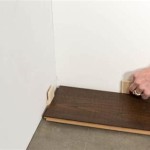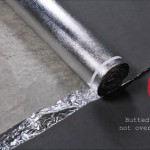Heated Laminate Flooring: A Comprehensive Guide
Heated laminate flooring offers a comfortable and energy-efficient alternative to traditional heating systems, providing warmth directly underfoot. Combining the aesthetic appeal and durability of laminate flooring with the cozy comfort of radiant heat, this system is becoming increasingly popular in residential and commercial spaces. This article delves into the intricacies of heated laminate flooring, exploring its components, installation process, advantages, potential drawbacks, and factors to consider when making a purchase.
The principle behind heated laminate flooring is relatively straightforward. A heating element, typically electric or hydronic, is installed beneath the laminate planks. This element warms the flooring material, which then radiates heat upwards into the room. The heat is distributed more evenly than with forced-air systems, eliminating cold spots and creating a more consistent and comfortable ambient temperature.
Components of a Heated Laminate Flooring System
Understanding the components of a heated laminate flooring system is crucial for making informed decisions regarding installation and maintenance. The primary elements include the laminate flooring itself, the heating element, the subfloor preparation, and the control system.
Laminate Flooring: Standard laminate flooring is comprised of several layers: a wear layer for durability, a decorative layer providing the aesthetic appeal, a core board typically made of high-density fiberboard (HDF) or medium-density fiberboard (MDF) providing stability, and a backing layer for moisture resistance. For heated laminate flooring, it's crucial to select a laminate specifically designed for radiant heat. These laminates are manufactured with a lower thermal resistance to allow heat to pass through more efficiently. The heat resistance, often denoted as R-value, should be as low as possible to maximize heating efficiency. Opt for laminates with a higher density as they tend to conduct heat more effectively and are less prone to warping or cracking under temperature fluctuations.
Heating Element: There are typically two types of heating elements used in heated laminate flooring systems: electric and hydronic. Electric systems utilize heating cables or mats embedded in a thin layer of cement or self-leveling compound beneath the laminate. Hydronic systems circulate warm water through tubes laid under the laminate. Electric systems are generally easier and less expensive to install, making them suitable for smaller areas or retrofitting existing spaces. Hydronic systems, while more complex and costly to install, tend to be more energy-efficient for larger areas due to the lower cost of running water compared to electricity.
Subfloor Preparation: Proper subfloor preparation is paramount for the success of any flooring installation, especially heated laminate flooring. The subfloor must be clean, level, and dry. Any existing imperfections, such as cracks or unevenness, must be addressed to ensure proper contact between the heating element and the laminate flooring. A level subfloor is critical for even heat distribution and prevents stress on the laminate planks, minimizing the risk of damage over time. A moisture barrier is also essential to prevent moisture migration from the subfloor, which can damage both the heating element and the laminate.
Control System: A thermostat controls the heating system, allowing users to adjust the temperature and set schedules. Programmable thermostats offer energy-saving benefits by automatically adjusting the temperature based on pre-set schedules. Some advanced systems can even be controlled remotely via smartphone apps, providing greater convenience and control over energy consumption. The thermostat should be strategically positioned to accurately measure the room temperature and ensure efficient operation of the heating system. It is important to choose a thermostat compatible with the specific type of heating element used (electric or hydronic).
Installation Process and Key Considerations
The installation process for heated laminate flooring involves several steps that require careful attention to detail. Whether opting for a professional installer or undertaking a do-it-yourself project, understanding the process is vital for ensuring a successful and long-lasting installation.
Subfloor Assessment and Preparation: Begin by thoroughly inspecting the subfloor. Address any cracks, unevenness, or moisture issues. Clean the subfloor thoroughly to remove any debris or contaminants. It may be necessary to apply a self-leveling compound to create a perfectly smooth surface. A moisture barrier should be installed to protect the heating system and laminate from moisture damage.
Heating Element Installation (Electric): For electric systems, carefully lay out the heating cables or mats according to the manufacturer's instructions. Ensure that the cables or mats are evenly spaced and securely attached to the subfloor. Avoid overlapping or damaging the cables. Once the heating element is installed, it must be tested to ensure proper functionality before proceeding.
Heating Element Installation (Hydronic): Hydronic systems require a more complex installation process. The tubing must be carefully laid out in a serpentine pattern and connected to a manifold. The manifold is then connected to a hot water source and a return line. It is crucial to ensure that all connections are secure and leak-proof. A pressure test should be performed to verify the integrity of the system before proceeding.
Embedding the Heating Element: Whether using electric cables or hydronic tubing, the heating element typically needs to be embedded in a thin layer of self-leveling concrete or a similar material to provide a smooth, even surface for the laminate flooring. This layer also helps to distribute heat more evenly and protect the heating element from damage. Allow the embedding material to fully cure according to the manufacturer's instructions before proceeding.
Laminate Flooring Installation: Once the embedding material is cured, the laminate flooring can be installed according to the manufacturer's instructions. Ensure that the laminate planks are properly acclimated to the room's temperature and humidity before installation. Use appropriate spacers to maintain consistent expansion gaps around the perimeter of the room. Avoid using nails or screws that could damage the heating element. Floating laminate floors are typically the preferred method for heated floors as they allow for expansion and contraction due to temperature changes.
Thermostat Connection and System Testing: After the laminate flooring is installed, connect the thermostat and test the entire system. Verify that the heating element is functioning correctly and that the temperature is being regulated as expected. Adjust the thermostat settings to your desired comfort level. Periodically inspect the system for any signs of damage or malfunction.
Advantages and Disadvantages of Heated Laminate Flooring
Like any flooring option, heated laminate flooring presents both advantages and disadvantages. Weighing these factors carefully is crucial for determining if it is the right choice for a specific application.
Advantages:
Comfort: Provides even and consistent heat distribution, eliminating cold spots and creating a comfortable living environment.
Energy Efficiency: Can be more energy-efficient than traditional forced-air heating systems, especially when used in specific zones or rooms.
Aesthetics: Offers the aesthetic appeal of laminate flooring with the added benefit of radiant heat.
Space Saving: Eliminates the need for bulky radiators or vents, freeing up valuable floor and wall space.
Cleanliness: Reduces dust and allergens compared to forced-air systems, which can circulate particles throughout the house.
Disadvantages:
Installation Costs: Can be more expensive to install than traditional flooring options, especially with hydronic systems.
Repair Complexity: Repairs can be more complex and costly compared to standard flooring, as the heating element must be accessed.
Potential for Damage: The heating element can be damaged by improper installation or heavy objects placed on the floor.
Heat-Up Time: Can take longer to heat up compared to forced-air systems.
Limited Flooring Options: Requires the use of laminates specifically designed for radiant heat, which may limit design choices.
In conclusion, heated laminate flooring offers a viable and comfortable heating solution. Thoughtful consideration of the components, installation nuances, system advantages, and potential drawbacks is essential for a informed decision and a successful installation.

Why Use An Electric Heated Floor System Flooring

Heated Vinyl Plank Flooring Everything You Need To Know

Electric In Floor Heating For Laminate Flooring

Underfloor Heating Foil Kits Living Heat

Under Laminate Heating Floor Systems Sdheat

Electric In Floor Heating For Laminate Flooring

Underlay For Underfloor Heating Laminate Or Carpet

Mi Heat Premium Heating 80watt M² 80cm Wide 5m

Install Underfloor Heating Under Wood Floor Discount Flooring Depotdiscount Depot Blog

Underfloor Heating Systems Types And Costs Fix
Related Posts








